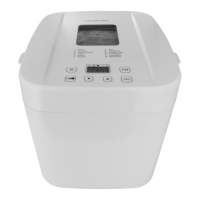7
Yeast
During bread making, yeast creates carbon dioxide gas which forms bubbles which are trapped in the
dough making it rise. Only use dried yeast marked “fast action”, “instant”, “easy bake”, “quick” or similar.
Most yeasts that are branded as suitable for bread machines will work well. Don’t use fresh yeast in your
bread maker. Check the “best before” date on yeast.
Liquid
The liquid ingredient is normally water although milk can also be used. Water makes a crispier crust. Milk
gives a softer crust with a velvety texture. The liquid should be warm (34-38ºC). Too hot or too cold will
inhibit the yeast. One simple method is to add 2 parts of cold liquid to 1 part boiling. For example, if the
recipe requires 300g of water, add 200g of cold water to 100g of boiling water. The result will be at just the
right temperature. Don’t use milk if you are going to use the timer. It might curdle before the bread
making process starts.
Butter/Oil
Where used, these make the dough more tender and enhance the flavour, giving the finished loaf a richer
quality. They help to retain moisture, making the bread keep fresh longer. We don’t recommend using any
type of low fat spread.
Sugar
Sugar adds flavour and texture, and helps with browning the crust. Honey, syrup, or molasses may be used
instead of sugar, provided the liquid ingredient is adjusted to compensate.
Salt
Salt helps to control the growth of the yeast. Without salt, the bread could rise too much, then collapse. It
also adds to the flavour. Keep it away from the yeast till the last minute, or it might inhibit the yeast.
Eggs
Eggs are used in some recipes to make your bread richer and more nutritious, add colour, and help with
the structure and texture.
RECIPES
• The recipes in this booklet have been designed specially for this bread maker.
• If you want to experiment, use the recipes as a guide, but vary the ingredients, vary the quantities,
taste the results. Keep notes. Write down what changes you make, and you’ll build up a range of
recipes which suit your taste. Keep notes of the not-so-successful ones too so you know what not to
do next time.
• You’ll find it’s best to change only one ingredient at a time – if you change more than one, you won’t
know which one was responsible for the effect you got.
• If you already have bread recipes, or find recipes in other publications, compare them with the
recipes given here, to find out which program to try first, then experiment for the best results.
• Be careful with quantities when using other recipes. For the first trial, don’t fill the loaf tin above
about a quarter full, certainly not as much as a third full. If you overfill it, the rising bread may push
the lid off.
• When experimenting, as a guide water/liquid should be added first, followed by dry ingredients and
lastly yeast or soda.

